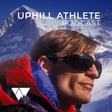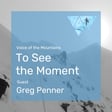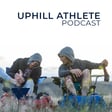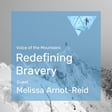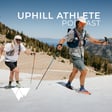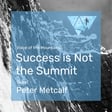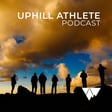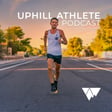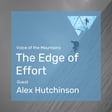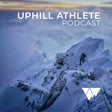Become a Creator today!Start creating today - Share your story with the world!
Start for free
00:00:00
00:00:01

Talking Injury with Staff Physical Therapist Pete Dickinson
Join Uphill Athlete co-founder Scott Johnston in a conversation with our staff physical therapist Pete Dickinson. In this episode they discuss Pete's background and affiliation with the U.S. Ski Team; the injury process; how to recover from injury; and strategies for injury prevention for athletes of all ages.
Transcript
Introduction to Uphill Athlete
00:00:01
Speaker
Welcome to the Uphill Athlete Podcast. These programs are just one of several free services we provide to disseminate information about training for mountain sports. If you like what you hear and want more, please check out our website, uphillathlete.com, where you'll find many articles and our extensive video library on all aspects of training for and accomplishing a variety of mountain goals. You'll also find our forum, where you can ask questions of our experts and the community at large.
00:00:30
Speaker
Our email is coach at uphillathlete.com and we'd love to hear from you. Welcome to another Uphill Athlete podcast.
Scott and Pete on Athlete Injuries
00:00:40
Speaker
I'm your host Scott Johnston, co-founder of Uphill Athlete and with me today is our staff physical therapist Pete Dickinson with whom I've had a long and in some case problematic relationship not because of personality but because of my propensity to get injured over the years and
00:00:59
Speaker
And today we're going to kind of dive into injuries in general, how they come about with a lot of athletes doing heavy training, and then hopefully also about how we can prevent them, what to look for, what to do, what to not do. But let me start off by having Pete do a little introduction of himself and talking about kind of how we got to start in this and how we ended up being physical therapists for the US ski team.
00:01:27
Speaker
Thanks, Scott. Well, I'm really excited to do this. And I think we should put out as our goal of this podcast is to heal most everyone's injuries that are listening to this with this podcast. I like that. So we can at least aspire to that maybe. Briefly about myself, I actually kind of got started my path to physical therapy. I came into that later in my
00:01:52
Speaker
careers, but I started off in outdoor education, working for NOLS in Wyoming, and then segued, I come from a medical family, and segued into working in the outdoors with people with disabilities that were paraplegics, quadriplegics, blind, deaf, that whole population.
00:02:14
Speaker
And then I was riding up to Charlotte with my buddy one day and asked what he was doing. And he said, oh, I'm in physical therapy, pre-physical
Lessons from Elite Athletes
00:02:20
Speaker
therapy. I said, oh, that sounds like the perfect field for me. And then started my path with a school to work my way there. And then, of course, with a love of the mountains, you start hitting the mountain towns. And so I lived in Breckenridge and then in Park City. And now, of course, in Paradise and Winthrop.
00:02:42
Speaker
And through those moves, I started working for a US ski team in various roles on various teams, first for the Alpine team, for the downhillers, and now for the cross-country team. And I'm also now exposed to biathlon and rowing and host of other sports at the national team level.
00:03:07
Speaker
which is quite interesting. But I also have a general clinical practice. And so I try to learn the lessons from my alien athletes that I work with, because they are aliens. They're amazing. They have amazing capacities. But trickle that down to those of us that are
00:03:31
Speaker
more common in our skill sets. So that brings me here and I get to live in Winthrop and run into patients such as yourself. And I understand patients like that because I also have many of those afflictions of needing to be active and being outdoors, even with an injury.
00:03:57
Speaker
Well, thanks. That's a great background to set you up for doing what you're doing. That's for sure. I think we should let people know that you have been a physical therapist to an Olympic gold medalist.
Health vs Injury Prevention in Olympians
00:04:07
Speaker
And I think that's a great kudo. Congratulations on that. As I well know, having trained a number of Olympians
00:04:15
Speaker
People operating at that level are really on a razor's edge in terms of health versus injury. Trying to balance the fitness gains with preventing of injuries is a really tough challenge. And so to get somebody to that level takes a great deal of coordination between the coach and the therapist so that the athlete doesn't arrive at the Olympic Games with some sort of injury that prevents them from being able to perform.
00:04:43
Speaker
It's amazing the resources they get with coaching, medical support, care and feeding. And yet we'll try and do many of those same hours or level of activities in our pursuits outdoors, but we don't have that support behind us. And it's hard and we can get into trouble at times. Certainly on your big climbs, I wonder,
00:05:08
Speaker
when you don't have that sort of all-encompassing support, but your commitment and effort is the same. That's a rough deal, I would think. Yeah, I think that's a great observation, and certainly true, especially when you're living on a glacier in a third world country, eating a substandard diet and sleeping on the ground, yet trying to perform at a really high level. That's a significant challenge. It's a lot different than
00:05:36
Speaker
you know, the Olympians that we've worked with who are being pretty much, you know, eat, sleep, train, they get treated with kid gloves and all that. And most of the rest of us just don't have that option. But I think you made a really good point, Pete, that might help us segue into the next part of this talk is that many of us try to train as if we were Olympians.
Recognizing Injury Symptoms
00:05:58
Speaker
I mean, we try to handle training loads and maybe they're not, you know, a thousand hours a year like some Olympians might be doing.
00:06:04
Speaker
But from a relative to our own time, energy, and capacities, we might be training very close to our limits, just like an Olympian is training close to his or her limits. And that's when we can go off the rails a little bit with injuries. And so maybe we could start off with that, talking about
00:06:27
Speaker
What are some of the telltale signs that people should be looking out for? What leads to injuries? What are the signals their body's sending to them so they can be aware that when they've got this niggling pain, is that a serious deal or is that just something that's going to go away? So how would you recommend people, first of all, just be on guard about injuries?
00:06:52
Speaker
Well, you're right. You know, we all need a team in our in our activities and we but we may not have that coach telling us what to do. And so we're we're on our own programs or accessing resources like through uphill athlete.
00:07:10
Speaker
to point us in the direction. But what I see very often is you get into that over enthusiasm syndrome and you do too much and you overload. So our body only has about
00:07:26
Speaker
Just in general, 10% ability to respond to additional load. And more than that, you tend to react. But at 10% around there, you'll adapt. And that's what we're always trying to do. But we're very motivated in our own pursuits, and so we'll overextend. But your body's really good at telling you that if we have the ear for it. Now, oftentimes, we shut off that ear, or we delay. I'm just going to put up with it.
00:07:56
Speaker
I often tell my patients, the sooner I treat a niggle, the better I can get rid of it. But if something starts accumulating and pain and inflammation lets you know, once that starts accumulating, it takes much longer to get rid of it. So I think listening to those warning signs of pain and inflammation, if that pain doesn't go away by the evening of the event,
00:08:23
Speaker
and lingers into the following day, that's a problem. If you have pain during the activity, that's the problem. So those are good guidelines to take to heart. Listen to what your body's telling you.
00:08:35
Speaker
I mean, we certainly preach that all the time to the athletes that we coach. And I think it's written at numerous times in our books that don't try to train through injuries. It's just a disaster. And I think there's, whether it's ego or just stubbornness, or adherence to a training plan that, blind adherence, let's call it, where the plan says you're supposed to go out and run for four hours today or do these intervals or whatever it turns out to be.
00:09:03
Speaker
and you get up in the morning and my Achilles is really tight today, kind of feeling what I did yesterday still, but the coach said, I'm supposed to do this. So out the door you go and you know, maybe, well, and I think you probably experienced this. I certainly have where you warm up and then that little tightness or niggling pain kind of goes away. And then you go, okay, I'm feeling better. I'm going to start this workout. And then about the third interval,
00:09:29
Speaker
bangle, something goes wrong.
Conservative Training Approaches
00:09:33
Speaker
And I think that... That last interval, it always gets you. Yeah. Well, it's because it's the last one. Yeah. Well, yeah.
00:09:40
Speaker
But you're not feeling well, you probably should stop, but the plan says, I got to do this many. So go out and do it. And then you're losing training time because then you're out two weeks. Whereas if you had backed off, you could dealt with that, done some treatment for it. And the next week, maybe you've hit that interval workout just fine. Yeah.
00:10:04
Speaker
Yeah, I'm one that likes to err on the conservative side with this stuff. Most of the folks that we deal with, this over-enthusiasm syndrome, as you call it, I think is a result of that type A personality that's attracted to endurance sports, where more is almost always better, up to the point where suddenly it's not better at all.
00:10:26
Speaker
And what I often counsel people is that if you have any doubt whatsoever about whether you should be doing that workout that day, that's probably your body doing all it can to get your attention to tell you, no, no, don't make me do that today. I'm not ready. Because most of us are usually chomping at the bit to get out and do these things. And so I kind of have given people that little piece of advice to help them, hopefully help them
00:10:52
Speaker
prevent an injury. And I think it's way better to show up at the starting line slightly under trained than slightly over trained. And especially over trained and injured. Yeah, without a doubt. You know, folks involved in endurance sports are used to putting up with a lot of discomfort. You know, it's part of what they do. And so being able to differentiate, you know, discomfort and pain is sometimes I have to actually teach
00:11:22
Speaker
my patients, what is pain? Because they can endure a lot. They can put up with a lot. That's part of what they're doing. And you've done ultras and at the end, those last couple hours, you're just enduring. But key into what our body's telling us and what our joints are telling us. Yeah, that's key. So when we think about prevention of injuries, what are maybe some of the
Strength Training Benefits
00:11:53
Speaker
What are some of the lessons you've learned? And what are some of the key points that people can do in their own maintenance program to help them prevent injury? Well, the biggest thing is to have a plan for your training. And then you can lay out your progressions of hours or activities and loads
00:12:16
Speaker
with some thought, and that can get you to avoid that increase, increases by 100%. That often happens when you're just winging it. So having a plan really helps you prevent injury by controlling your loads. Injuries are caused by many things. There are equipment causes, footwear, if you're running a lot, that's an easy one. You've got to change that out quite often.
00:12:48
Speaker
technique of your sport. That's why it's nice to be coached. I'm involved a lot with Nordic skiing and that has a specific sequence of hip hinging and people that get into too much back arching and other instability motions set themselves up for injury. So sometimes having being coached in a sport, even if you've done it for a while, can be a really helpful thing.
00:13:16
Speaker
And then Scott, we've talked about this extensively. Strength training as a preventative activity is huge, both for your tenant health and for your ability to recover from training loads.
00:13:30
Speaker
through the hormonal stimulus that strength training gives you. Can you talk about that hormonal stimulus? I mean, I'm quite familiar with it, Pete, but I'm afraid there, I'm guessing that a lot of our audience probably doesn't really understand that. So especially the benefit for someone like who's doing, who's an endurance athlete that's doing very high repetitions in their normal sport activities, doing very high repetitions at relatively low loads. And what would be the benefit of high load strength training and hormonally for them?
00:14:01
Speaker
Yeah, because you wouldn't think it would apply, right? We have the said principles, specific adaptation to impose demands. It's got to look, feel, taste, and smell like your sport to benefit you. But strength training is different from that. And without going too much in the weeds with that, for an endurance athlete to do, say, two times a week strength training is incredibly helpful because
00:14:28
Speaker
through the metabolic responses to load in your tissues, it stimulates a chemical response, a hormonal response. And so you get an increase in human growth hormone, testosterone, all these good activities that help you naturally, they help you recover from all the fatiguing events that you're doing and repetition with your endurance sport. So it's a huge recovery tool
00:14:56
Speaker
for all the hours of endurance activity. Strength training, it takes half an hour, you know, several times a week. It's one of the biggest bangs for the buck that you can do for injury prevention and recovery. And then you get that additional benefit of you get better fatigue resistance in your activities and that it takes less energy to accomplish the task because you're stronger. Relatively, it's less of a load on you.
00:15:26
Speaker
So that's why it's always nice being stronger.
00:15:30
Speaker
Yeah, I'm a big fan of that. And I've used that sort of a max strength training protocol with high level athletes and skiers that I've coached in the past where in particular after a very hard training session in the morning, maybe we were doing intervals or maybe they were out for, you know, some kind of roller ski tempo run type thing. You know, they're pretty high intensity for a long duration, pretty, very fatiguing.
00:15:59
Speaker
And then in the afternoon, we would come in the gym and do a very short max strength protocol. And tell me if you think this is right, but I felt like it didn't even matter what exercises we did as long as they were maximally
00:16:16
Speaker
exerting effort. So we might go, you know, even though I don't think these things, let's say exercises like, you know, a deadlift or something, I'm not really convinced that makes you a better cross country skier, but it's a very easy way to load your body, the high, you know, there's so something like a squat or a deadlift, then maybe they'd come in and do, you know, three or four sets of three or four reps. And maybe they might do some weighted pull ups, you know, some other maximum upper body thing.
00:16:46
Speaker
to get that that hormonal response you're talking about and what i've noticed with that and myself and the athletes i've coached is they all report that the next day they feel more recovered if they've done that kind of a afternoon workout and sometimes it's as you know it can be hard to after a really exhausting morning workout it can sometimes be hard to gin up the enthusiasm or the energy to think oh god now i have to go into the
Pairing Strength and Endurance
00:17:10
Speaker
gym and
00:17:10
Speaker
Lift through these heavy lifts, but it's so short That I think most people come out of those sessions feeling a lot better than they went in It's really common to Combine that with an interval session on the day and then that allows you to take the following day completely off and get a really nice block of Rest and recovery so it's great to do a two-day session with that
00:17:37
Speaker
And many of your listeners who might just have a nine to five job, and they're sneaking in workouts when they can, but they've got a stressful, busy work week, they'll find that sneaking in a couple strong lifts during the week helps their work activities. On a Friday afternoon, they'll be less fatigued, they'll be sharper, and they'll have a little bit more energy for the weekend when they can pack in a few more hours.
00:18:04
Speaker
Yeah, I certainly have seen great benefit from it. I still use that for myself with trying to do maximal effort resistance movements. In my case, because I'm climbing more these days and running less, I try to, they'll end up being sort of semi-climbing specific, you know, so usually some kind of upper body pulling exercise or something like that. But I'm not convinced that it really matters that much. What do you think about that?
00:18:31
Speaker
Is it just the effort that matters or is it the actual muscles you're using? We're probably looking for general physical preparation with our strength training and not the specific sport preparation side of things. So it's not going to
00:18:48
Speaker
make you as a mature athlete, specifically better in the sport, but it helps everything around it with your fatigue resistance, with your tolerating hours. So it's a key thing. In the younger athlete, it's
00:19:05
Speaker
very much key for them being able to do their sport because they're physically immature and they need, their strength needs to get better at least in skiing for them to ride a flat ski and to handle and to assume the positions of the sport. But for the more mature athlete, it feels good and it's one of your activity strength training is one of your activities to control pain.
00:19:31
Speaker
prevents injury and helps tendon health, just a whole host of things. Well, I think this is a really great message. I'm glad we're spending a bit of time, maybe even too much time on it because one of the things I hear a lot from endurance athletes, and I'm sure you have, the amateur endurance athlete, they don't really want to do strength training. They don't like going into the gym. They feel like, well, I'd rather go for a half hour run than a half hour in the gym.
00:19:58
Speaker
And it's sometimes hard to convince them that, yes, this isn't directly related to making you a faster runner, but it's gonna give you this underlying base of support, whether it's prevention of injuries or maybe increasing your stride length by a half an inch by being a bit stronger. And I think that's a message that more endurance athletes need to understand. Most of the high-level endurance athletes that I've worked with
00:20:26
Speaker
and still work with, do some kind of strength training. Whereas when I get down into the amateur and beginner level, I'll ask people, so what do you do for strength training? Well, I don't like to strength training.
00:20:44
Speaker
Well, what was strength training associated with back in the day? You know, certainly in our years, it was just football or something like that. And it was muscle hypertrophy. You know, you're trying to get big. You're trying to get big. And when you do true strength training and high loads,
00:21:02
Speaker
where you're looking to increase the strength of the muscle, you're not increasing the volume or bulk of the muscle. So we prescribe heavy loaded strength training for endurance athletes because like our gymnast, tiny people going uphill, you want to be strong, but you don't have a lot of mass that you're carrying.
00:21:23
Speaker
It's kind of counterintuitive, but the heavy loads, when you're kind of towards your max at, say, between one and five reps, that's when you're gaining strength, but you're not gaining any additional weight of muscle mass. Now, if you get into those of us that are getting a little bit older and we want to get a little bit more muscle mass because we're losing it because of the aging process, we'll go up to 10 and 12 reps, and that'll help stimulate a little bit more growth of the muscle.
00:21:52
Speaker
you can strength train, get stronger, but not gain weight. And so that's one of the fallacies that I'm always having to dispel when I talk about strength training.
00:22:04
Speaker
Yeah, it's certainly something I've preached in the books. And I think it's, you know, I think bodybuilding has kind of corrupted in the way most people look at strength training and commercial gyms, you know, you walk in there and there's a lot of really big guys strutting around. And I think that can be intimidating for folks, but it can also people say, well, I don't want to be that big, but you don't have to get that big. It takes a lot of work.
00:22:27
Speaker
and a lot of calories to get that big. And I think that what I like to preach with endurance athletes is that strength training is just one of the tools in our toolbox to make us better. We don't care if you can deadlift more weight. That's not the point of the strength training we're preaching.
00:22:44
Speaker
We want you to be able to run faster or ski faster uphill or farther or whatever. We want you to perform better in your sport and that strength training is a very useful support tool that can help you, rather than relying only on the strength levels that you're using during the sport, which for endurance sports, the strength levels are relatively low.
00:23:08
Speaker
Right. I mean, you mentioned something about, you know, personal PR, like for a deadlift. When we're doing our strength training, we're keeping our, we call it a rep or two in the pocket. It's pretty comfortable strength training. I don't want you straining and going to your max because your injury risk goes up. It's not worth it. So one of the techniques we utilize is lift comfortably heavy, but you're not
00:23:38
Speaker
You're not grunting and grinding out to that last rep.
00:23:43
Speaker
And so for the aging athlete that you and I are both now members of that group. And- I'm 12 between the ears. Yeah, but that's unfortunately me too. That's one of our problems. Yeah. But so, and we have a lot of folks that pay attention to what we're saying who are in our same age group who want some information about, you know, okay, I have never done strength training in my life and I'm 60 years old.
Strength Training for Older Athletes
00:24:11
Speaker
what do I do to get started and how will you know they under they might understand these principles that we're talking about that yes being stronger will help you in all facets of your life not just being an athlete but um they're a little afraid so what would you suggest as kind of a way to dip your toe into strength training for somebody who has very little or no experience with that oh in general i i promote um
00:24:38
Speaker
Let's see, to do a nice general program, you want to do a two-legged exercise like a squat or a deadlift. You want to do an overhead exercise, overhead press. You want to do a pull, a pull-up. And you want to do a single-leg exercise. And Scott, I know you've got a lot of great resources on the website.
00:25:01
Speaker
with the videos of all these things. And cycling through, we recommend doing three sets one day, five sets another day, say these four exercises. That's two days a week, comfortably hard,
00:25:20
Speaker
once you're comfortable with the movements. We'll just do body weight on the movements to begin with. But it's pretty simple. We want to train movements, not muscles. And so the movements to train can be quite simple, but the hinges, squat, a press, a pull, and a single leg exercise because we need to be good in a
00:25:41
Speaker
in single leg strength. And give me an example of that, a single leg. So that would be a forward T or a single leg deadlift or a step down. Or you step down or step up, which I've seen on the website very well done. And initially without weight and then progressing into weight resistance.
00:26:07
Speaker
These can be quite simple. You can learn these movements online because there's dead simple movements. There's coaching available to help guide you through it as well if you feel you need it. If you're starting to have pain with the movement, that's a good indication you need help.
00:26:33
Speaker
And the purpose of the single leg stuff, I should, I've talked about that at length and I know you fully understand it, but why don't you tell people the difference between doing a bipedal exercise like a regular squat versus something like a single leg deadlift? Well, we want to help ourselves for preparing for our outdoor activities. And running is certainly, you can consider it bounding from one leg to another leg.
00:27:01
Speaker
hiking is more of a press. It's a big single leg activity when you're stepping up. You also need to have the strength to control your pelvis in your back because it's hanging off of that hip. And if you're not strong and you're wobbling, you're going to
00:27:18
Speaker
had the potential lead to difficulties with, with your spine and your pelvis. So, um, it's really important to be a solid in your single leg activities. And it's amazing. You don't train it. It's, um, it's an eye opener, uh, when you start going to it. Uh, and then in general, uh, for balance as well, you want to be comfortable, uh, stabilizing on one leg, um,
00:27:44
Speaker
And because we don't want to hit the ground. And the older we get, the less we want to do that. I don't know about you, Scott, but I don't bounce as well as I used to. No. The older we get, the less we want to be hitting the ground very hard.
00:27:57
Speaker
And I definitely noticed deterioration in my balance as I've gotten older. And now I spend a little time every day on balance exercises. And I've already noticed, just in a matter of a couple of weeks, a significant difference in my single leg balance since I started that. And I think that a lot of people, maybe it's me in particular, but do you see that in general with older people that their balance starts to go?
00:28:26
Speaker
Oh yeah, that's our number one concern is fall risk in people when you start getting frail and further down the road. But, um, uh, the, um, deficits happen long before, uh, you become frail. Um, so, uh, but really now you're touching on what is the magic pill that people want for, um, for aging and recovery. Um, and it's, um, doing these basics of strength training.
00:28:54
Speaker
Keep your game elevated through our active older years. And it is the most important thing you can do. Our strength is what's decreasing as we're aging. It's not so much our aerobic capacity or it doesn't decline as sharply as our strength. And the dysfunction limitations you get from not being strong are huge.
00:29:20
Speaker
Yeah, and I think one of the gratifying things about strength training is that the gains can come fairly quickly, unless you're already very, very strong at something. But for people who haven't done a lot of it, it can be very encouraging. And as you know, the initial gains mainly come from neurologic responses. Your brain figures out how to wire the muscle fibers to fire in the right order to make that movement more efficiently or more powerfully.
00:29:47
Speaker
And it's quite remarkable how fast your brain responds to this kind of stimulus, you know, compared to endurance training, which is a fairly slow long term process and sometimes very challenging to even see the gains, you know, their gains are sort of very incremental.
00:30:04
Speaker
but certainly what I've seen with my own strength training, a lot of the athletes I will work with is people getting really strong in a matter of a few weeks at certain lifts or certain movements. Yeah, endurance training is real disappointing because usually when I try, when I do something, I expect the immediate superior dramatic results. And yeah, it takes a lot longer going through the endurance process, but strength training,
00:30:33
Speaker
Um, you'll, you'll, it has a pretty quick effects, um, and dramatic, uh, Oh wow. Movements following where your other work outside of, of, of strength training are is noticeably easier. Your, your tasks, uh, you're just going to tolerate things so much more. So, um, yeah, we're on our soapbox on this, but good, good. I think we, it's something, it's a message. Go ahead. Sorry. We all should be strength training. It's easy.
00:31:04
Speaker
It's not that hard. Pick four movements. Have a lower volume day one day, a higher volume another day, and learn how to pick up heavy things.
00:31:15
Speaker
Yeah. So you don't hurt your back. Yeah. Oh yeah. You have to learn how. So, uh, uh, and there's resources for that, but we always stabilize our spine, uh, uh, using our, our core, pushing out with our core, using our lats, our glutes to create, um, rigid structures to help protect her back. Cause that's a big issue for the aging athlete is our spine. Yeah.
00:31:39
Speaker
I'm an inch shorter than I was 10 years ago. And I know it's due to compression in my spine.
00:31:48
Speaker
So here's a question, a personal question for me then. I don't do heavy squats or deadlifts anymore. I do heavy single leg things so I don't have to load up my back as much as you. Is that a good idea? You know, for people who are already beginning to see maybe they've got some disc deterioration or issues and putting a 200 pound barbell on your back, is that a good idea for somebody with a back problem?
00:32:13
Speaker
Right, so there are a lot of caveats to everything. For the aging athlete, we need to work with our existing injuries and capacities. And so, yes, our proponent for heavy strength training needs to be within the spectacles of who you are and what injuries you're dealing with.
00:32:39
Speaker
Certainly relatively, yeah, doing the heavier one-legged strengthening, you can still get some load in through your legs, but it doesn't have to be on your spine as much. And, you know, I think compensating for the spine is huge. We'll do more core training and mobility work in the older athlete.
00:33:05
Speaker
But also we want them to be able to go overhead. I think that's important for the spine for core control. But it's a big bug. I often treat the hidden back injury in the older athlete where they think they have a hamstring tendonitis, but it's actually just a radiculopathy coming out of their spine. So it's something we're continually managing
00:33:33
Speaker
Um, uh, yeah, for the older athlete. Interesting. Yeah. So, and I mean, I've certainly seen that where the place where it hurts may not be where that may not be the injury, just the way you're feeling the pain. Um, well, let's talk a little bit about, uh, you know, the people who are already injured.
00:33:53
Speaker
And I think you've told me there's some kind of general protocols for treating injuries, even if we don't even have to get down into the specifics of what injury. But what would you say in general would be some of the bullet points for people who are facing injuries, soft tissue, perhaps probably the most common, in what they should do? Well, if we need to unload the tissue, you want to take your rest up front.
00:34:21
Speaker
get that big block of rest in and don't dribble it out because then you're not being effective if you're not fully resting and having the initial acute inflammation calm down. So that's a common mistake I see people make. You want to keep doing things and stuff, but get all your rest and pack it up front so that then we can be done with that and we can be moving on with treatment.
00:34:50
Speaker
That's where people sometimes shoot themselves in the foot by not being effective enough with their initial rest. And then for the tendonitis and mini injuries, we need to be really consistent with the loads.
00:35:07
Speaker
and not be yo-yoing the volumes and intensities and hurting and preventing your body from adapting.
Injury Management Strategies
00:35:17
Speaker
Your body's always going through this react, adapt, react, adapt sequence. So we want you just to steadily steady adaptation process and listening to the response to the treatments. Make sure you can have some pain, but that night,
00:35:33
Speaker
It's calming down. It's it's not worse the following day Those are really good guidelines going through this injury treat whatever the injury is this process And that's where sometimes you need a coach and you need need help going through that process because you May think you should do an activity, but it's probably not the best activity for your injury So don't be afraid to reach out for help
00:36:02
Speaker
And being, not going back out to do the same thing that injured yourself in the first place might be one of the rules you want to get across too. If you've gotten an Achilles tendon problem because you upped your running mileage too fast, then continuing to run might not be a very wise thing. And in fact, that plays into what you said initially is that when I, and I, this is what I counsel people, when they first feel these problems, stop.
00:36:31
Speaker
stop and jump on it with both feet right away, try to get on top of it, get beyond it. And often you can do that in a fairly quick, short order, but we've also, you know, I know you've seen, you've seen me doing this in the past where coming to you a month later, my achilles tendonitis is not only better, it's actually worse. And you'll say, well, how much did you stop running? And say, no, I didn't stop running.
00:36:55
Speaker
I cut my mileage down, but obviously once that tendon is compromised, just cutting down the mileage isn't enough anymore. You have to pretty much lay off it. Right. The longer an injury has gone on, the longer it's going to take to deal with.
00:37:15
Speaker
So say if it's a one to four ratio. So you deal with the first niggle, you're done with it in four days. I call that success. You've got something going on for six months and you're going to be two years working on it. And now that may be exaggeration, but hopefully not.
00:37:35
Speaker
It's probably pretty close from my experience. Yeah, it's it's pretty close So hop on those things earlier. It's okay. It's okay to address pain and limited function and you want to do that before It gets a head of steam Because then then you're you are having access professionals You're not gonna be able to do it on your own or you're not gonna be successful doing it
00:38:02
Speaker
What's the latest in your knowledge of using eccentric loads versus concentric loads in treating tendonitis? What do you preach that nowadays?
Modern Tendonitis Treatment
00:38:14
Speaker
Okay, that's great. So the science on this is always moving. And
00:38:22
Speaker
And that's the way it is in many things in sports medicine. Like with the kneecap pain, we used to think, oh, you could strengthen your fastest medialis. And now we come to find, oh, that doesn't do anything. It's not effective. Your lateralis is working just as hard if you're trying to activate your medialis. And so we do a lot more with hip and fascial interventions. Okay, so tenonitis has gone through many of the same changes where
00:38:50
Speaker
These two researchers, Kerwin and Stanish, promoted eccentric strength training and were able to show some nice results with Achilles tendonitis. And that went with also that they felt we could focus, we could isolate the tendon load with the eccentric strengthening. It tends to skew more towards the tendon than the bulk of the muscle with eccentrics.
00:39:19
Speaker
New research has shown that heavy loaded strength training is more effective for the Achilles tendonitis. And there's probably caveats to that as well. And what that tells us, when you look at the research, what it shows is that strength training is effective for treating tendonitis. And so that's the take-home lesson.
00:39:47
Speaker
for that, because it's not really an inflammation in the tendon. We think now, although some indicators might be a little bit of inflammation, but we think that there's a degenerated portion of the tendon. You've got to strengthen the surrounding area that's not as bad. You're not going to change what's already degenerated. That's a done deal. So you got to get the rest of the tendon healthier and stronger. So, but it's got to be a process.
00:40:16
Speaker
So for the Achilles tendonitis, we'll build from the ground up. We'll start with some isometrics. Then we can switch and both feet. Then we can increase the load and go to one foot.
00:40:32
Speaker
And then you can start doing some calf raises and then start going heavier on your calf raises, but not just doing these centrics. We want to train proper function throughout the...
00:40:48
Speaker
the tendon. And then there's also a recent thing about the neurological control of the muscles that you're using to accomplish the function. And when you have tendon pain, that's impaired. And so you need to retrain the neurological control of all the structures involved going through that limb. And they'll do that with metronome training.
00:41:11
Speaker
with exercises to a metronome with an external cue instead of just self-guided. And it helps your neurological control of the tissue. So things are always changing. We're always kind of guided by the evidence out there. But you've got to be super consistent with your approach with tendonitis.
00:41:39
Speaker
often with isometrics, we'll do two or three times a day. Then as you start getting more bigger loads and movements, we'll go once a day. You may need to take days off. Then we'll start weaving in higher function movements, doing lunges, doing some little hops, and just increasing the function and control of that limb. But it's a nice gradual,
00:42:04
Speaker
gradual increase. But the big key is being consistent. When people aren't consistent, that's when the progress is delayed and you have the tendonitis that lasts forever.
00:42:19
Speaker
So this is the consistency and the progressivity of this is exactly like proper training in that way. It is proper training. Training doesn't work unless you're consistent. And in order for training to actually have a long-term benefit, it needs to be progressive. In other words, progressively gets harder and harder. Loads get bigger and bigger as you go along.
00:42:41
Speaker
And this sounds, you know, exactly like that. And so this is where I can see, you know, having the help of a professional who sets you up with, you know, first determines what the problem is, and then secondly, helps you, helps set you up with that progressive program. Yeah, I mean, I couldn't.
00:43:02
Speaker
Yeah, training errors are unnecessary, but happen. And so you decrease the training errors. If you have a big goal, get a coach. And then from with an injury, I'm just coaching through the injury, training through the injury. But with rehab, our increases are really small and subtle and aren't
00:43:28
Speaker
what you're usually used to in your general approach to, to physical condition. So I'll bet. Yeah. So that's one of the, I think one of the challenges for a lot of athletes when they become injured and they start doing this therapy, you know, it feels so the loads are so low. It doesn't, I'm not doing anything. Yeah, exactly. But they're not able to do anything. If they go back to the loads that they are accustomed to, they'd be right back to being injured. Um,
00:43:56
Speaker
Let's address a few questions here that we got in. When I asked for information, especially for aging athletes, so here's
Long-term Fitness Plans
00:44:07
Speaker
one. I'd like to hear how to develop a multi-year plan for a bigger or more rigorous climb. I think especially in older athletes, avoidance of injury while gaining skills and strength. So your response to that was don't hit the ground, right?
00:44:24
Speaker
Yeah, don't hit the ground. Spend some time expanding your skill set, acquire new skills, and then avoid injury as you're going through that process. Because you lose training time with injury. And when you have a big goal, you want that consistent ramp to it. Many of the things we've talked about, you want to incorporate, of course, with the strength training.
00:44:54
Speaker
in an older athlete and also listening to the injuries that we carry forward through our lives and working around that. And don't try and put that square peg in that round hole.
00:45:12
Speaker
Yeah, and it seems like when it comes to this injury avoidance and the hitting the ground ideas that we've got older athletes are not going to recover as fast. And they probably aren't going to respond even to the physical therapy as quickly as they did 30 years before. And that makes it even more imperative that as we age that we don't screw up and get hurt.
00:45:41
Speaker
I know I've become much more cautious in the last 20 some years with my willingness to push myself because I know what happens when I do get injured and how much time I lose and then it's a real struggle to regain that lost ground and you may never regain some of that lost ground.
00:46:00
Speaker
Yeah, we're always resistant to, I've hucked over that jump. I should still be able to huck over that jump. But not realizing that risk reward ratio there, that if something does happen, you really lose training time and you really endanger your goals. So you need to make some choices for the aging athlete.
00:46:26
Speaker
into the exposure to injury that you do. That's hard, because we're so motivated, and we think we should still be able to do the things we've always done. But yeah, sometimes you should listen to that. Steve and I talked a little bit about that.
00:46:46
Speaker
Steve and I spoke about that last week when we did our talk about aging and what we have noticed with ourselves that our, you know, our risk tolerance is so much lower than it was 20 or 30, 40 years ago, kind of sort of shocking. Well, here's another question. I'm a 60 year old, 66 year old ultra runner and ski mountaineer. Should I worry about doing damage to my body when running or training for a hundred miler or a big 5,000 meter peak
00:47:14
Speaker
5,000 meter peak ascent. Yeah, no, that's a great
Listening to Body Signals
00:47:21
Speaker
question. When should we be concerned about our activities? And usually our body lets us know. And so I don't
00:47:32
Speaker
put limitations or throw limitations out on folks. I let their bodies tell them what's going on. So if your joint, if your knees aren't responding to the training loads, you need to listen to that and try to adapt, change to some different methods, cycle the volume differently.
00:47:56
Speaker
Maybe try shorter, more intense efforts to increase your rubber capacity in a different way. And then save your big volumes for not as consistent through the week, but maybe once a week, once every other week.
00:48:11
Speaker
a lot of games you can play with that, but listen to what your body is telling you. It'll let you know if it's too much for the aging athlete. Some people are amazing. Scott, you're amazing what you can do with your knees as they are, but not everyone's like that. So you need to listen to what your individual response is and don't get caught up in what you should do. You know, should's a bad word.
00:48:38
Speaker
I think it's very easy for us to compare ourselves to other people and especially to compare ourselves to other younger fit people. As we get older, there's fewer of us going out in the mountains and doing these things we like to do. And oftentimes we end up partnering with somebody, in my case, somebody 30 years younger than me. And it can be kind of a rude slap in the face to realize, hey, I'm not going to be the guy that's breaking trail today.
00:49:08
Speaker
In this deep snow, I'm gonna have to want to let one of these young bucks get out there and do that work I'm just if I don't I won't you know, I'll be so exhausted. It won't be any fun So I think that it's that's sort of we have to realize our limitations, which is challenge as we get older
00:49:26
Speaker
Yeah. Well, you've done really well using guile and cunning to work around that trailer. So I'm, I'm impressed. Well, here's another one. And this is something I think most of us older people can relate to is this guy is saying, I got a lot of old injuries, mostly involving joints. So addressing the issues of joint pain, mobility and prevention of injuries. Is there a magic pill for me?
Muscles as Shock Absorbers
00:49:51
Speaker
Yeah, magic pill, we talked about that, didn't we? Strength training. The nice thing about strength training is your muscles are the shock, you think about it this way, your muscles are the shock absorbers for your joints. So the stronger, better functioning muscle structure you have, your joints see less stress. And so that's a great way of helping things out with the joints. And then mobility of the soft tissue.
00:50:20
Speaker
We talk about stretching and stretching is the length of the joint, but we really also like rolling the tissue to get the internal tissue structures, the fascial structures, more mobile because they start getting sticky and that affects the forces going through the joints.
00:50:40
Speaker
So that's why you hear people rolling so much. Yeah. Because of the fascial. That's, that's kind of my go to my maintenance that I, and I tell people that I feel like the older we get, the more maintenance, like an old car just needs to have more maintenance. So I spent a lot more time now on my little rolling, either on a ball or on a foam roller or something than I ever had, you know, I didn't
00:51:04
Speaker
You know, until I think probably 15 years ago, I never would have considered that even the need for maintenance. Probably wasn't very smart of me, but now I preach it even to the younger athletes that I coach that, hey, get on this thing. Start doing your rolling. It's nice to have somebody else massage you, but most of us don't have that luxury. And the nice thing about the rolling is that you can target the areas that you can feel are needing it the most.
00:51:33
Speaker
Yeah, with most of these activities, the benefit is dose dependent. So if you're relying on other people to do it for you, you're not going to get enough of the medicine. So training is medicine. And also doing your own rolling mobility maintenance activities. You're going to get a lot more out of it if you incorporate your own routine into it.
00:52:01
Speaker
Here's another one, Pete. This is a fellow that has had a meniscop to me. Yeah, meniscectomy. Meniscectomy. Okay, in both knees the last eight months, but I'm back to training without any real issues. I'm signed up with RMI to climb Rainier next August.
00:52:18
Speaker
and I'm test driving your two-month training plan for a climb of Katahdin later this summer. I substitute a bike ride for one of the Zone 1-2 runs every week and try to hit the hills as much as possible. Any suggestion on how to maximize my chances on Rainier for next year? I also want to balance my training with my desire to preserve knee cartilage, what knee cartilage I have left over the next 15 years or so.
00:52:45
Speaker
Well, we're preaching to the choir with this guy, right, because he's already substituting some activities using different methods. So he's just not hammering his knees with the same activity over and over again.
00:53:02
Speaker
So that's great. And then strength training, of course, would be a key. But then the biggest thing would be not to get into, to listen to your body, not to get into an overreach situation. He's got a big goal and he's going to be really motivated to get the training in. But just to be consistent with the increases of the training and respond, take the rest days, do different activities when you're
00:53:31
Speaker
sensing some pain and loss of function occur. Yeah. Great. I think we've covered most. There's a couple of other questions, but I think we've covered them quite a lot. Here's somebody who's asked the best methods of injury prevention. And I think we kind of covered that where it's the training being moderated or progressive in your training load and doing some strength training and rest and that sort of thing.
00:54:01
Speaker
anything else? Oh, I know one subject that I do want to touch on real quickly than that, because my article on my own knee replacement a few years ago that I put in on our website has engendered a lot of curiosity on people's parts that like, well, how are you, how are you managing to run again on this knee and that sort of thing? And I mean, I've kind of developed what I
00:54:26
Speaker
tell people, but I'd like to hear from you as a professional, you know, what are the cautions? And I know you have definitely some strong feelings about this, that not everybody's going to be running on a knee replacement. So why don't you just talk a little bit about that as a warning or a caveat for folks who are considering a knee replacement.
00:54:46
Speaker
Yeah, well, with any surgery, we want open expectations. And we have aspirations, but then we also have different people have different realities on their personal gifts, capacities, talents, and that affects things in what you can do post-surgery.
00:55:11
Speaker
In your instance, Scott, you are an incredible athlete. You're one of the most, the quickest recovering athletes I've had the pleasure to work with. And that's a unique gift, a unique skill you have. And you know that you recover so quickly from trauma and from surgery. Not everyone is like that. So going forward, you need to be open to how your body is responding to whatever surgery
00:55:41
Speaker
it is or injury and adapt accordingly. We don't want to get in a situation where you expect the same results as everyone else. When it comes down to yourself as an individual, you're a steady case of one and need to respond what your body is telling you. So that's my
00:56:11
Speaker
Big recommendation is open expectations. Do all the things that you can for recovery. Some people will be able to run, some people won't. It's not our expectation, but some people come from a different starting point. It's not fair, but it's the way it is.
00:56:31
Speaker
Nope, that's true. It isn't necessarily fair. Life isn't meant to be. Well, Peter, are there any other topics you feel like we've overlooked or we should touch on before we wrap this up?
Mastering Training Principles
00:56:44
Speaker
I've been a great talk. I've really learned a bunch and I hope other people have, but I'm sure there are some tidbits buried away in that head of yours that you could see.
00:56:54
Speaker
Well, it's not from me. It's what my patients tell me. And I learn from them. And especially with the elite athletes and with the gold medalists and national team athletes I've had a chance to work with, they do the basics really well. We're always searching for something special, something unique, but doing the basics of proper training progressions
00:57:23
Speaker
10% rule, getting your strength in, taking care of yourself. All these things are the components of what make people set up for elite performance. I hope you have another podcast on mindfulness training because that's also a component
00:57:50
Speaker
of all this managing stress and anxiety and the physiological impacts of that. But that's for another time. Would you be willing to do that? Only with a lot of help. I'm not qualified. That's a nice teaser out there. Do the basics well.
00:58:15
Speaker
Well, we certainly see that a lot, Pete. I mean, I know you do too. People coming in to us looking for that last 1% when they've got, let's say, they're aerobically deficient or they're very strength deficient.
00:58:32
Speaker
But they're wanting to know, should I be doing a ketogenic diet or should I take these supplements? For an Olympian, it's probably worth examining those things. It might pay off a tenth of a percent or a half a percent. But for most people,
00:58:49
Speaker
there's so much low hanging fruit that you just focus on those basics and establish a strength base, establish an aerobic base. Once you've done those things, then you can start getting sexy with your training and trying different stuff. But until you've done those things, you're really wasting a lot of time searching for this sort of magic bullet approach. And it's sometimes hard to
00:59:14
Speaker
get people off of that mindset because the popular press keeps telling people that you can run your best marathon in six weeks if you follow this program and that sort of thing. Get these amazing abs in four minutes a day, three days a week. Just stuff like we're bombarded with that stuff all day. I got to do a tendon training one on healthcare tendons.
00:59:38
Speaker
It's exactly right, but it's hard. It requires a lot to do the basics really well. In a long time. Yes, it takes a long time, but people shouldn't underestimate the sophistication and difficulty to doing the basics really well. Yeah, exactly. I mean, you and I both know that from experience and all the elite athletes that we've had the privilege to work with
01:00:07
Speaker
they have spent the bulk of their adult life and maybe the bulk of their life attaining, getting those basics, getting their house in order, getting those basics done exactly. It's a multi-year process and so you're not going to go from being a sedentary 50-year-old to
01:00:29
Speaker
You're running a hundred mile race in one year that just you know, that's a recipe for disaster doing something like that and and that's often one of them I think one of the purposes actually that we've created uphill athlete is to try to educate people and cut through some of the nonsense it's being constantly put out there on the internet and the popular media
Long-term Training Perspectives
01:00:51
Speaker
about
01:00:51
Speaker
These shortcuts and quick, you know, quick fixes and that sort of thing which we know very well don't work and in many cases can be really harmful. And so having people come into this with a These kind of programs, whether it's an injury recovery or just a training program with this idea that this is a long term, you know, you you've spent
01:01:12
Speaker
I've got a hypothetical person that comes to us at 45 years old and then says, I want to climb Everest. But I've never done much physical exertion because I work a crazy busy job. I'm a very successful person. I also got a family. And what I will often tell those people is,
01:01:31
Speaker
Think about that three to five years from now. It's going to take us that long to get you ready. It's probably not going to happen. Maybe you could pull it off. Maybe you're just mentally incredibly fit or incredibly tough. A lot of people can suffer just amazingly. But I've also seen a lot of people very unprepared when they go into some of these mountain things. And some of these, especially on these big mountains, it can be extremely dangerous to go into these things unprepared.
01:02:00
Speaker
I really hope that this message that we're giving people today, I think it aligns really well with the overall points we try to make on uphill athlete is to give this solid information for people to make wiser choices and hopefully have a long, they could stay healthy long enough to build that base of fitness. Yeah, the resources available on uphill athlete
01:02:29
Speaker
is amazing and I tell folks all the time that to get online you're very giving of content and just incredible resource and it's the real stuff. You've done really good bridging formal training to those of us that want to
01:02:52
Speaker
be more successful outdoors and it wasn't being done until uphill athlete came along. So it's been a true gift to the outdoor community.
Consulting Professionals for Recovery
01:03:02
Speaker
Thanks Pete, that's nice to hear. We've worked hard at it and you've been a really crucial part of it and folks that are interested in speaking with Pete one-on-one about their own personal injury issues
01:03:14
Speaker
Pete can be reached through our injury part of the forum. We have a whole injury section that Pete monitors and you can also reach him there if you wanted to set up some kind of a consultation offline. He does teleconferencing that way and he can probably help you. He's a very gifted physical therapist. I've worked with an awful lot of him over the years and Pete's right at the very top of that list. That's why he's working for us.
01:03:40
Speaker
And thank you very much for your time today, Pete. It's been great chatting with you. And if you think of somebody who can do all that mindfulness talk, let me know. OK, we'll get on that. Thank you. All right. And thanks, everybody, for joining us. For more information, just go to our website, uphillathlete.com. You'll be able to find a lot more of this kind of thing there. Thanks again, and see you next time.
